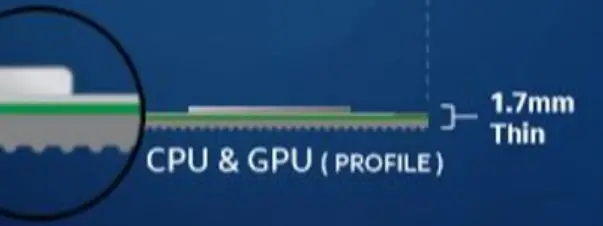AMD Tech Day: the momentum continues with new products, new prices, and 12nm and 7nm announcements
An assault on Intel’s EMIB
Just yesterday Intel also launched their Kaby Lake G processors which integrated their Kaby Lake CPUs along with AMD’s Vega graphics processor and HBM 2 in a single package. This is the first consumer product to feature HBM 2 and also the first consumer product to incorporate an EMIB – Intel’s patented technology that enabled tighter in-package interconnections.
We will bring back one of those slides from Intel’s presentation.

Their processor has a Z-height of just 1.7mm which is enabled by their patented EMIB technology.

Now let’s go back to AMD’s Radeon Vega Mobile discrete GPU. Take a careful look at the features AMD is advertising:

Did you catch it? As it turned out, AMD’s own graphics processor with HBM 2 also has the exact same Z-height of 1.7mm. The same height as Intel’s processor with EMIB technology. But how is that possible? It turns out AMD’s graphics processor will make use of an “embedded interposer”. Note that this is our term, not their as we don’t currently know what GlobalFoundries is calling this or what other enhancements were introduced if any. From what we understand, they found a way to further embed the interposer in the package substrate and by the look of it they have managed to do a good enough job that it matches Intel’s EMIB thickness advantage, albeit likely not in terms of cost and some of the other advantages.
Like Intel, AMD’s extremely thin package now makes it possible for them to enter the ultra-thin mobile device market. Additionally, OEMs will now have the opportunity to adopt the technology in thinner mobile workstations and other more powerful mobile devices that traditionally needed to have a thicker form factor.
Radeon Everywhere
AMD continued to promote their Radeon Everywhere strategy which is an aggressive attempt to push their own graphics IP to other companies. Of course, their most recent client is Intel. AMD noted that while it may seem strange that AMD’s products will now be incorporated into Intel’s products, it is part of their Radeon Everywhere strategy. Other products include PlayStation and Microsoft’s XBox.

First 7nm
It’s no secrete AMD has been preparing for the launch of their 7nm products sometimes next year. The real surprise came at CES. Lisa Su said that the first product that will be manufactured on 7nm process is going to be Radeon Instinct Vega. Note that it’s not actually confirmed if this is GlobalFoundries 7nm or TSMC’s. AMD can contract out either foundries. The product is designed specifically as a GPGPU for machine learning. Although it’s not 100% clear, it appears that 7nm Vega will remain exclusively for machine learning applications. Lisa su noted that sample shipments will start this year. Those products will be branded as Radeon Instinct and be exclusive for machine learning.

The real mainstream consumer 7nm graphics products will be based on Navi which will replace Vega sometimes around the 2019 timeframe. Additionally, like Zen 3, AMD is also planning a sucessor to Navi based on a 7nm+ enhance node around 2020.

Machine Learning Software Stack
AMD has talked a little about a the software stack that they have been developing. The software will go along with their machine learning products and include support for general machine learning and frameworks such as TensorFlow and Caffe 2.

AMD is not a large company and software development is a precious commodity. On the other hand, you have NVIDIA which has a well-funded software development team. In order to take on NVIDIA AMD is taking advantage of the large amount of open source software that is out there.

Final Thought
After capping off a great 2017, it’s clear that AMD is going to do whatever it takes to continue to build their momentum. For 2018 AMD is planning a very product-rich roll-out that include new low-end mobile parts, as well as new and improved desktop, workstation, and enthusiasts Zen+ parts. To top it all off, AMD noted that they are on schedule for introducing Zen 2 based on a 7nm technology likely sometimes next year.
But AMD isn’t stopping here. In the graphics department they have introduced new high-performance mobile graphics processors with HBM2 technology and have even announced the first 7nm product that will be sampling this year. It seems that AMD might be actually end up shipping 7nm parts before Intel will even launch their equivalent 10nm-based products, although we don’t currently know if those initial parts will be on GF or TSMC’s 7nm.
Overall we are very pleased to see AMD doing very well, bringing new innovation and competition to the PC market. We can’t wait to see what they have planned next!
–
Spotted an error? Help us fix it! Simply select the problematic text and press Ctrl+Enter to notify us.
–
